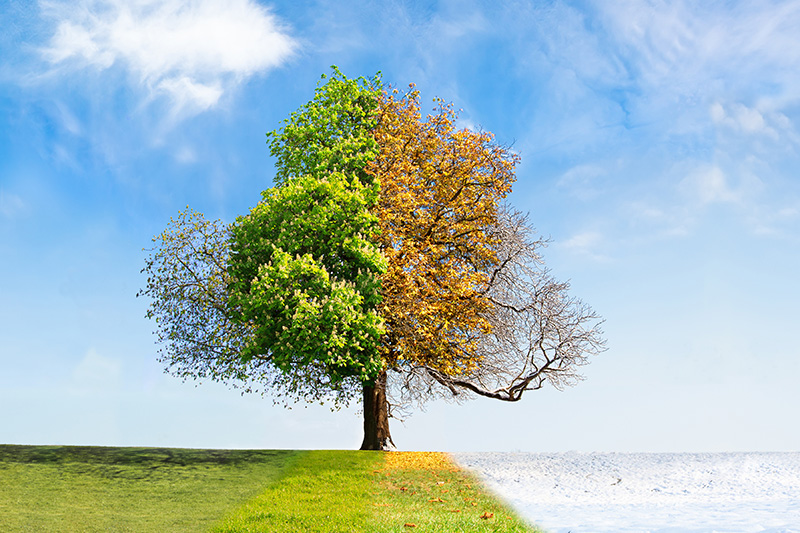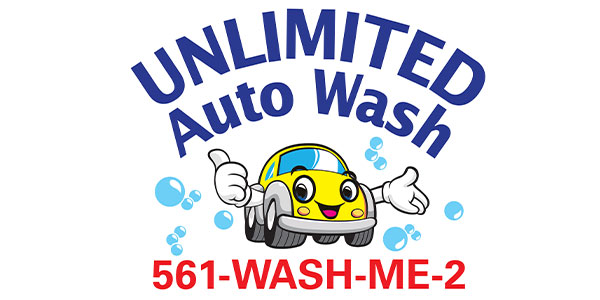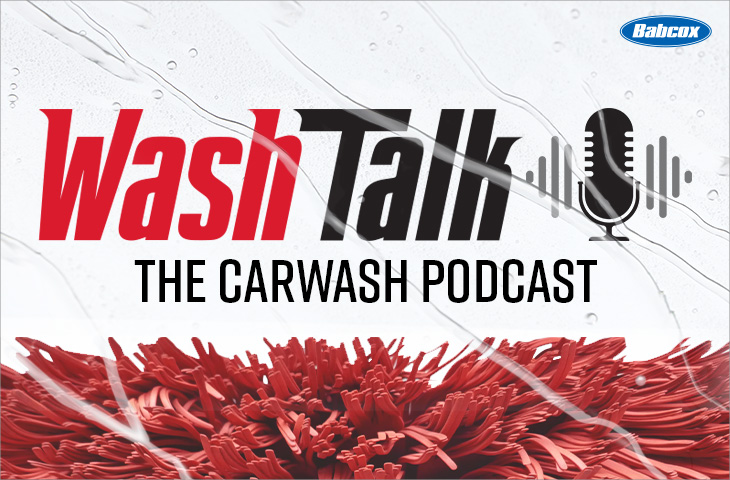Wildfires in Appalachia. Flooding in Texas. Snow in California. These were just some of the severe (and sometimes strange) climate-related events that made news around the country just in the latter half of 2016.
Carwashes are subservient to the weather. Many close on rainy days, but sunny days may see lines out to the street. The occasional bad weather day may not make a terrible impact on overall profits, but what happens when there are prolonged, seasonal events — and what happens when some of those events aren’t normal for your region of the country?
Related: Carwashing by region: Finding the right wash process for your area
During this past spring, Professional Carwashing & Detailing polled carwashes across the country about the weather they experienced last autumn and winter. As we approach this time of year once again, we want to share with you some of the results from that survey as well as some insight from carwash owners across the nation about how they dealt with the various situations last year and how you can prepare for such events in the future.
The South was burning
Fall 2016 saw one of the worst droughts in recorded history for the Southeast, several cities of which broke rainless records by having approximately two-month-long dry streaks.1 These conditions, which led to cities such as Birmingham, Alabama, declaring ever-worsening stages of drought emergencies, provided the dry tinder for the terribly destructive Great Smokey Mountain wildfires.
Many cities did install drought measures regulating water consumption, and according to a story we reported on in November 2016, carwashes such as one Mister Car Wash location in Birmingham did limit their services. For instance, when a Stage 3 Drought Emergency was declared, the carwash ceased pressure-washing all cars that came through and stopped offering high-dollar detailing services due to the amount of water the business knew it would use to finish them.2
But, how else can a carwash deal with drought conditions? Harrison Hempill, chief operations officer for Zips Car Wash, which has dozens of locations across the Southeast, states, “We can always communicate to our guests and community about our efforts towards water efficiency through the constant assessment of our mixing stations, output devices and reclaim systems. This will help affirm that using our sites is the right thing to do should they feel the need to wash their vehicle during drought times.”
As such, contrary to what one might think, the article reported that any perceived losses that the Birmingham Mister Car Wash location took in the fall were made up by sheer numbers of customers, breaking records in October.2
“There is a balancing of guests in a drought environment,” explains Hempill. “Those that don’t consider carwashing as a want will simply stop washing, while those that are environmentally conscious that normally wash at home will come to an express wash.”
Related: Dry conditions highlight driveway washing’s downfall
One operations snag that the Mister Car Wash had during the rainless months was having to rework the maintenance schedule, making for long days for the employees. Without rainy days on which to come in and do maintenance, employees were having to stay as late as one o’clock in the morning to clean and prep for the next day.2
In addition to drought, our survey found that 60 percent of Southeastern respondents reported that a warmer winter decreased business somewhat. As for Zips, Hempill adds, the chain’s northern sites also experienced fewer boosts in winter — normally one of the company’s busiest seasons — due to fewer snow events.
On a warm winter’s night
The North is known for its especially cold and snowy winters. However, winter is a double-edged sword. While consistent snow can mean a great boost in profits, too much or too little can mean a drop in business if you aren’t prepared.
The Northeast and Mid-Atlantic
Like the Southeast, the Northeast and Mid-Atlantic were afflicted with drought last year; some areas even suffered extreme drought from August 2016 to March 2017.3But as mentioned earlier, this can be a boon for carwashes. “Dusty cars and daily forecasts of no rain are good for us,” notes Dave DuGoff, owner of College Park Car Wash in Maryland, in Northeast Carwasher.4 Furthermore, he adds, having a good, snowy season and a great pollen season are additional yearly boosts for carwashes, should they occur.
The Northeast and Mid-Atlantic also experienced a warmer winter than usual, according to the Northeast Regional Climate Center (NRCC). In its March 2017 report, NRCC stated, “For 10 consecutive months, the Northeast averaged out to be warmer than normal, but March brought an end to that streak.” However, even if the winter was warmer, the Northeast was still impacted by several snowstorms and nor’easters, some of which generated some of the snowiest months and days for certain areas, such as Binghamton and Syracuse, New York.3
Results from our Mid-Atlantic survey responders were mixed: 37.5 percent reported “increased frequency/intensity of winter storms”; 25 percent noted that the region was not afflicted with unusual amounts of severe weather; and 12.5 percent indicated that there was no snow. However, 50 percent reported that business decreased greatly due to overall severe weather. Moreover, of the 75 percent of respondents who answered that winter was warmer than usual, two-thirds of those noted that business decreased somewhat or greatly compared to previous winters, while the other third reported business increased somewhat.
For DuGoff, 2016 was his best year yet, due to the drought and oft-threatened snow that never hit. However, he did pose an interesting question: Is it better to have too much snow or simply threatened snow that might miss your area but cause the cities to lay down salt and sand regardless?4
It’s a conundrum with an unclear answer. According to DuGoff, since weather forecasting is more accurate now, “When the forecast is for snow five days out, even though it may be sunny and mild, our business slows down. Then, if there is a snowstorm, the city shuts down — at least in Washington, D.C. If it takes a couple of days to dig out of a major snow event, we end up losing a week or more. Then, we are jammed and feel like we’re on a treadmill at twice the speed we can reasonably do.”4
The Midwest
Unlike in other parts of the country, 62.5 percent of respondents from the Midwest noted in our survey that the region did not experience any extreme conditions, such as drought or increased storms. However, one strange weather-related phenomenon the Midwest did experience was a relatively warm winter with less snow.
According to AJ Zappitelli, owner of Zappy’s Auto Washes, located in Ohio, winter is the busiest time of year for his carwashes. The Midwest generally experiences winter weather from November until March, and since snowfall is more normal than not during that time, transportation crews frequently treat the roads with salt.
Zappitelli says, “People are aware of the damage salt causes to the exterior and undercarriage of their car. They view washing their cars as an investment, hoping to extend the life of their vehicles.”
According to our survey, 62.5 percent of Midwestern respondents claimed that this year’s winter was warmer than normal; however, responses were split evenly between whether carwashes sustained, increased or lost profits.
Zappitelli confirms that Northeast Ohio did experience a warmer winter this year, which naturally resulted in less snow, but he says that Zappy’s did not experience a decrease in profits because of it. “We used this opportunity to market our other services. Zappy’s Auto Washes wants to be known as a one-stop shop for car care. Car care is a year-round market, regardless of weather,” he educates.
Conversely, in February 2017, PC&D reported on an instance of a carwash in Windsor, Ontario — just across the river/Canadian border from Detroit, Michigan — having the complete opposite effect. The article reported that for Riverside Car Wash, February is normally its busiest month, and on a typical day, the business might serve 110 cars. However, according to the article, the record-warm February meant there was no salt on the roads, which resulted in fewer people needing their cars washed. It led to such a drastic reduction in business that the carwash had to close down some days.5
So, if you’re in an area that regularly experiences snowy winters and your carwash relies on the profit that comes from those seasonal, salty cars, what can you do to keep profits consistent?
Related: New AAA report underscores importance of winter carwashing
Zappitelli offers an answer. “Carwashes must diversify their businesses in order to overcome mild winters with less snow. Through the years, we have added multiple detailing services and a paint correction facility to our carwash portfolio. Adding these services helps balance out a mild winter with little snow,” he explains. “[We are] consistently looking for ways to diversify our business so we are not significantly relying on one service.”
Snowed under in the West
But if the Midwest experienced a milder winter than usual, the West by comparison was walloped with snowstorms. Brad Hailstone, general manager of Wiggy Wash, located in Utah, claims that while summertime is generally the busiest season overall, “Wintertime will have busier individual days or weeks.”
With that in mind, one might think: The more winter weather, the better, right? Not necessarily. According to our survey, 100 percent of respondents from the West indicated the area experienced an increase in the frequency/intensity of winter storms, the result of which was decreased business, and Hailstone agreed.
“This winter, the storms were closer together. Usually during the winter, we get a good storm or even a few days in a row of storms, but then it will clear up and be really busy. This past winter, it would storm and then only clear up for a day or two, but it seemed like there was always a storm in the forecast, which discouraged people from washing,” Hailstone explains.
However, Hailstone argues that a way to help overcome poorer winter profits due to increased storms (or even less snow) is to manage labor effectively. “We focus on keeping labor and other costs in check as well as promoting our unlimited programs with the ability to wash every day, even if it is stormy,” he notes.
Soaking in the rain
While snow can provide profitable opportunities for carwashes, its liquid counterpart, rain, is the ultimate detriment, and two regions of the U.S. — the West Coast and the Southwest — got more this past year than they bargained for.
The West Coast
Californians were dreaming of rain for years until this past winter season. Like the Southeast and Northeast, California was also in a severe drought. But, according to both our survey and Chris McKenna of McKenna Assets LLC in Los Angeles, California, that drought suddenly turned into a season of rain.
In a normal year, McKenna elucidates, his carwashes’ busiest and best month is usually December, if days are clear and the temperature is in the 70s. Last fall and winter, however, saw a very different situation.
“We got more rainfall than we’ve ever had,” McKenna clarifies. “So, we went from drought conditions in California [to] no longer [being] in a drought here. That took care of itself from one winter.”
According to McKenna, it was the most amount of rainfall the area has seen in around 20 years, and it lasted from about mid-October until the beginning of March. But, he notes, this is a pretty typical phenomenon for California. “We go into drought, and then every seven to eight years, we go into drought
conditions and then it rains a lot and the drought’s gone. This was a little over the top,” he explains. “But it fits the normal weather pattern, from what I know of growing up here in Southern California.”
Unfortunately, while the area desperately needed the rain, its effect was quite detrimental for business. McKenna notes that his carwashes alone were down 50 to 60 percent of their normal business, and he says it was the same throughout the state. In addition, California had a colder and snowier winter than usual, he says, with record snowfall in the Sierra Nevada.
Of Californians, McKenna notes, “When it’s super cold, people don’t go out. So, when it’s down there in the 50s, which is rare here, people don’t really want to come out. We do our best business between 65 and 75 [degrees]. If it’s too nice out and it’s a weekend, then we lose business too because everyone goes to the beach. There’s a certain sweet spot that we like in the weather.”
As for the rest of the Pacific Coast — Oregon and Washington — McKenna notes that they too were hit with a similar situation in terms of the deluge of rain and colder winter, but he adds, “I think they’re sort of used to getting more rain … they just kind of work around it. Down in L.A., everyone freaks out when there’s just a few drops of rain.”
The Southwest
Rain also made a tremendous impact on parts of the Southwest, notably in Texas. In fact, in 2016 Texas not only had its wettest August since 1914, but it also had the wettest 24-month consecutive period in its recorded history.6 Lanese Barnett, director of marketing for The Car Wash Companies, located in Texas, says that March through October are usually the companies’ busiest months; during the first and last third of that time period, they usually receive some bouts of extreme weather that can help to drive business, but on the other hand, when the dry, summer months arrive, they have a steady influx of business as customers stick to a more consistent schedule.
As for last year, Barnett notes, “We had our best year in 2016. Though the rainfall was above average, it often avoided the weekends and actually helped us more than it hurt us. Not to mention, the start of 2016 was unusually warm with days in February in the 70s, jumpstarting our year.”
Like several areas of the country, however, winter 2017 was warmer than usual, resulting in decreased business. Barnett adds that it’s normal for the area to have at least a few occurrences of sleet and ice that prompt the cities to lay down sand and salt, which in turn prompts customers to rush to the carwash after the weather clears, “resulting in record-breaking wash totals,” according to Barnett.
Barnett provides this advice for carwashes in areas that might be suffering from prolonged periods of rain: “Educate customers on the importance of regular carwashing and vehicle appearance care through staff training, in-store promotional materials or signage, your website, etc., to hopefully add vehicle washing to their normal routine regardless of an extended rainy period. You can also promote monthly plans as a solution to customers obsessing over the weather.”
In conclusion, there’s no telling how the weather could affect your carwash, because as our survey and those we interviewed have shown, the results will vary even in the same region. The best thing you can do, however, is to prepare yourself for any weather eventuality, no matter how unlikely it might seem in your part of the country.
Sources:
1https://weather.com/climate-weather/drought/news/record-dry-streaks-southeast-drought-fall-2016
2http://www.wbrc.com/story/33636990/birmingham-car-wash-benefiting-from-drought-conditions
3http://www.nrcc.cornell.edu/regional/narrative/narrative.html
4http://northeastcarwasher.com/wp-content/uploads/2015/09/Spring-2017-Vol.-22-No.-2.pdf
5http://www.cbc.ca/news/canada/windsor/car-wash-blues-early-spring-1.4005909
6https://www.dallasnews.com/news/weather/2016/08/31/august-2016-ties-century-old-record-wettest-august-texas













